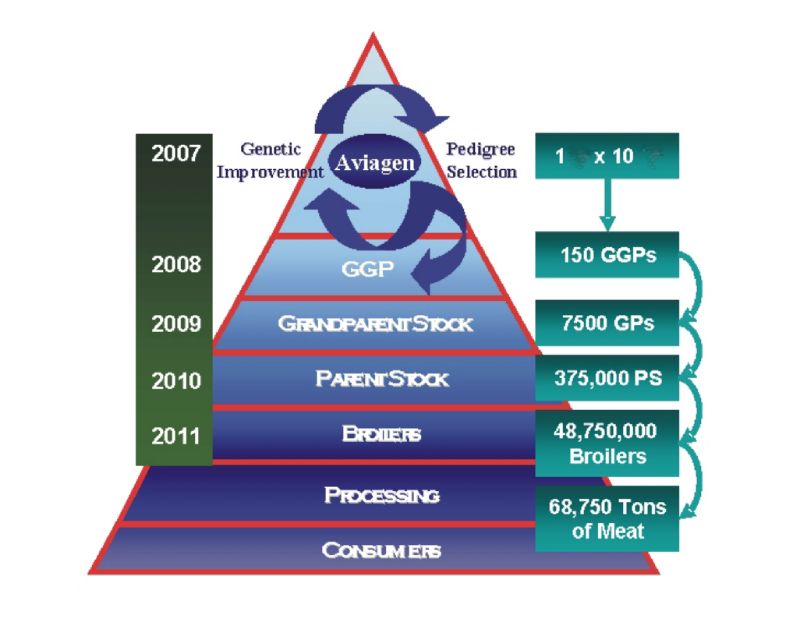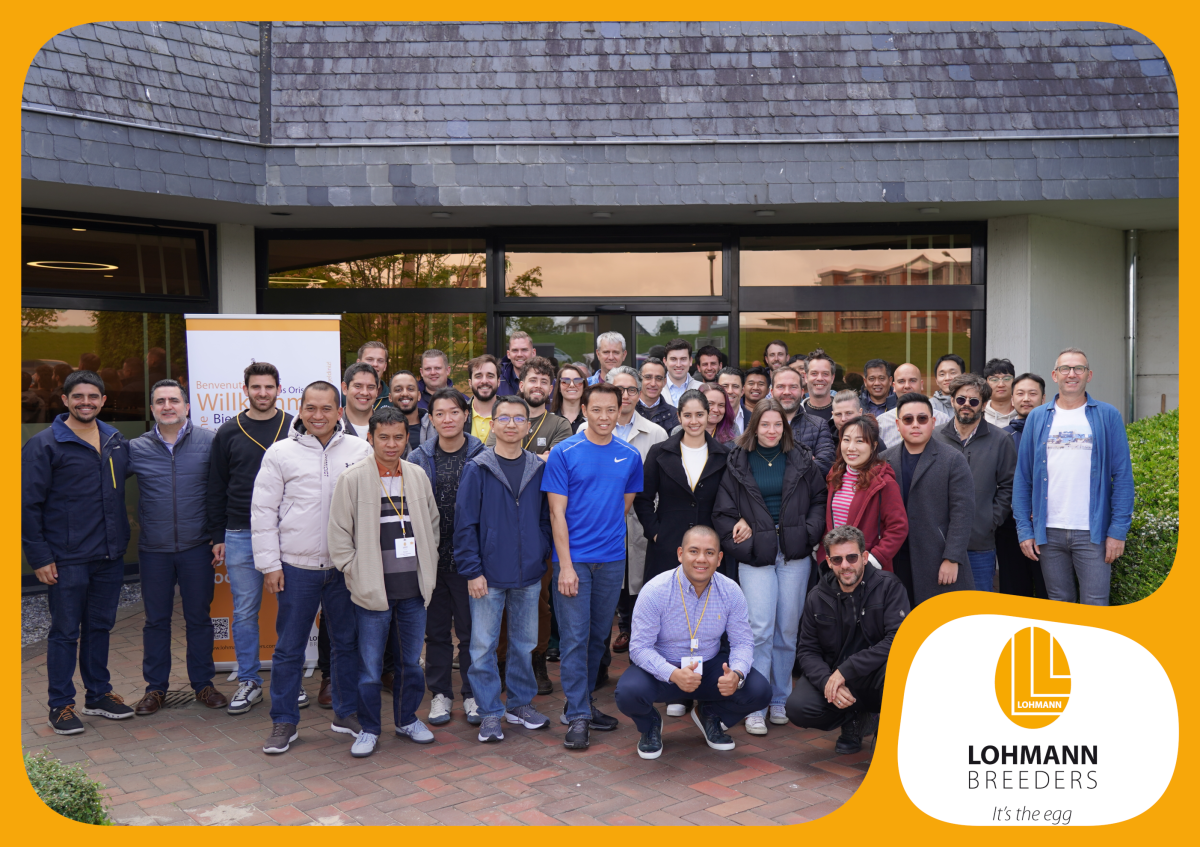Summary
In broiler breeding, selection is often said to be focused only on rapid growth at the expense of traits
important for animal welfare. In fact, economically important traits are balanced with traits which are
important for animal health and welfare. At the beginning of broiler breeding, during the 1960’s, in
the USA selection for liveweight at market age was predominant but over the subsequent years many
more characteristics were included in the selection program (fig.1)
Improvements from the selection program are passed down the pyramid of production (fig 2.) over several years through breeders, broilers, processing and finally to the consumers.
Selection to improve leg condition through removal of TD is an example of the time involved to improve complex traits, almost 30 years and also the need for specialized equipment (the Lixiscope to measure condition of live animals).As a result of this selection incidence of TD in the field could be reduced from over 50% to less than 1%.
Advances in measuring techniques, supported by developments in molecular genetics will allow further progress in welfare and economic traits which will improve the competitive ability of poultry in the world market.
Scientific reviews and the introduction to papers frequently repeat and regenerate old, misunderstood
or incorrect views regarding the nature of poultry breeding, particularly if they support the reasons
for the research. In this regard a failure to acknowledge the long term attention to traits associated
with health and welfare is often repeated with the implication that breeding companies have only
recently addressed welfare issues in breeding programmes. The major economic traits receive most
attention due to their historical commercial importance and because progress in their selection has been
most significant. The more difficult traits, both in terms of measurement and in heritability have thereby
seen slower progress but these gains are no less significant to the breeders and for the industry.
In order to understand why changes and improvements may take a long time let us consider the
nature of poultry breeding and how breeding programmes have evolved. In the beginning of the broiler
industry 50 to 80 years ago the “breeds” were produced by many different small breeders and most
were single lines. Once the concept of hybridization was understood some breeding companies began
to develop multiple lines and sell commercial crosses but, particularly in the United States, some
single line breeders remained and the customers were free to buy males and females from different
sources to create their own “cross”. At a time when there were many breeders this “lottery” genetics
could frequently produce good products which on occasion were better than those supplied as a
package. Additionally the scale of operations meant that very small differences could be realized
economically in specific feed or housing environments. Relatively quickly the breeding companies
realized that the end product should be a planned combination of traits from lines with known characteristics. Initially however this was confined to putting broiler characters in the male and reproductive characters in the female. From the 1960’s breeding programmes have moved from very simpleImprovements from the selection program are passed down the pyramid of production (fig 2.) over several years through breeders, broilers, processing and finally to the consumers.
Selection to improve leg condition through removal of TD is an example of the time involved to improve complex traits, almost 30 years and also the need for specialized equipment (the Lixiscope to measure condition of live animals).As a result of this selection incidence of TD in the field could be reduced from over 50% to less than 1%.
Advances in measuring techniques, supported by developments in molecular genetics will allow further progress in welfare and economic traits which will improve the competitive ability of poultry in the world market.
mass selection for liveweight to include ever more traits as the technology to measure these and the computing power and programmes to analyse them developed. At least ten sectors can now be identified in the “pie” of genetic selection criteria and several of these are composed of multiple traits such that at least 40 traits would be considered at the time of each final selection. Although the diagrammatic representation of this is necessarily very simple it has evolved over many years as technologies facilitated change and traits were added.
Genetic Selection Criteria.

The two ends of the spectrum of selection traits over time
The modern breeding programmes have traditionally been represented as a pyramid with the primary breeding (genetic) section sitting on top of the production chain delivering genetic material. These diagrams can also display the time frame from pedigree to broiler production of around 5 years and a multiplication such that one male and ten females at the pedigree level generate almost 50 million broilers or nearly 70,000 tonnes of meat.

Traditional breeding Pyramid with timelines and volumes
Such a diagram highlights an important fact. The breeding company must correctly anticipate the needs of the industry at least 5 years ahead. However being realistic it could take at least five years to develop a new line to be available for the great grandparent level of the production process which moves the timescale from identified need to availability at broiler level closer to 10 years. This of course means that the breeding companies must be incorporating considerable feedback into their breeding programme strategy and the sources of this feedback include all levels of the production chain through to the consumer plus interest groups, regulatory matters and developments in science. The weighting and analysis of the feedback is critical to the success of the programme.
To return to the specific issue of welfare and one aspect which receives considerable attention – leg health – I would like to use this as one example of the biological time frame necessary to effect significant changes in a selection trait at the commercial level.
Almost 30 years ago I “inherited” a breeding programme in the UK which already included selection for leg condition scores recognizing the importance of this to bird health and welfare. Next, UK breeding companies collaborated in a program of work carried out by John Mercer at the University of Edinburgh assessing the opportunity to select specifically against Tibial Dyschondroplasia (TD). This was published as a PhD thesis in 1983 and showed the clear opportunity to select for reduction in this condition. The positive indications from this work led to the first use of the “Lixiscope” as a selection tool in the late 80’s, a procedure which has continued to the present day. Clearly therefore addressing welfare issues is not a recent trend in Poultry breeding. Aviagen’s specific data relating to eradication of TD shows both a reduction in the variability of this trait and also its incidence.
The data from the breeding programme have recently been supported by a commercial study in Denmark reported at the Nordic Poultry Conference (Petersen 2005). In this study the field incidence of TD was shown to reduce from 57% to 0.7% between 1999 and 2005. In addition to the genetic changes over this time we are also aware of changes in the nutrition which aided the reduction in TD. These nutritional changes had resulted in part from recommendations from the breeding company – highlighting the importance not only of making genetic improvements but also supporting these with technical advice in the field. In addition to the specific improvements in TD score there was an associated overall improvement in leg health.
Taking this specific example shows the importance of dissecting and separating the various components which contribute to an industry “problem”. To solve the problem, a trait or condition has to be identified which can be measured reliably and routinely and has been demonstrated to be heritable. Only at this point can it be incorporated successfully into the breeding programme and translated into an improvement in commercial stock in the field. Such improvements are essential for a breeding company to remain in business, but throughout the process of genetic improvement the overall characteristics of the product must remain acceptable to the customers in the industry who buy them.
A subject which highlights the difficulties facing geneticists in anticipating industry concerns is skin lesions on the legs. During the 1980’s in the UK (one of the few countries to leave hocks on the ready to cook carcase) hock burn became a major issue. This was also linked to perceived welfare conditions of bird rearing. We initiated a process to address this in the breeding programme and considerable reductions in hock burn can be demonstrated at pure line level. Subsequently in regions which sold feet (paws) to the Chinese market absence of foot pad lesions (pododermatitis) became economically important. This was then proposed as a measure of welfare status for the EU Broiler Welfare Directive. Our historical data and trial work indicated a negative relationship between hock burn and foot pad dermatitis. The birds with better initial leg condition also spent more time moving and standing than sitting down and hence presented their foot pads to the litter, thereby reflecting litter condition. Considerable work to understand the causes and hence potential for reduction of this problem has been carried out. The final version of the EU Broiler Welfare Directive does not contain the same emphasis on (or routine measurement of) pododermatitis. Our programme will continue to address this issue because it is important.
In the last five years we have been given new tools and techniques from the science of Genomics. Aviagen has made a major investment in this area which will allow us to identify genetic markers which can be used to enhance the existing assessments particularly in traits related to health and welfare. Historically these have been difficult to examine without the use of complex and difficult challenge studies which are not suitable for use in routine breeding programmes. Using data from case studies in a field environment we expect to identify markers which can further broaden the range of selection traits.
Initial comments referring to only a limited number of major traits when appraising the broiler breeding industry presupposed that growth rate is the only issue driving a breeding program and that it is automatically negative for welfare. This would have been correct 40 years ago but since that time the level of sophistication in both listening to and anticipating the needs of the industry, consumers and regulators has changed significantly. Along with this there have been major improvements in the measurement, collection and analysis of relevant data in order to develop the products with the correct balance of traits which are needed by the industry. The breeding industry may have shown a reduction in the number of independent companies involved, but those who responded correctly to the challenge now offer a much greater range of products to satisfy the various sector requirements of this industry worldwide than were available 20 years ago.
Although this presentation used a health and welfare example to show the impact of Poultry Genetics we now recognize that we have entered a period of focus on the environmental impact of the livestock industry. The genetic improvement in Feed Conversion Efficiency has had and will continue to have a significant effect by both reducing the nutritional inputs required by poultry farming and also reducing the waste outputs it generates as a result of the past and future activities of poultry breeding. Finally, in support of this view the contribution of poultry breeding companies to the broader aspects of the global food market covering layers and turkeys as well as broilers has been reviewed by Flock et al. (2005). This paper outlines the further contribution through eradication of vertically transmitted diseases, selection for general liveability and not least the dissemination of management recommendations which help customers to reduce losses at the commercial level.
Flock, D.K., Laughlin, K.F., and Bentley, J. (2005) Minimizing losses in poultry breeding and production: how breeding companies contribute to poultry welfare. World’s Poultry Science Journal 61:227-237.
Mercer, J. T., (1983) The genetics of leg abnormalities in poultry, with particular reference to Dyschondroplasia. Ph.D. Thesis, University of Edinburgh.
Petersen, J. S., (2005) Management factors influencing broiler welfare. Proceedings of Nordic Poultry Conference, Bergen, Norway
Zusammenfassung
Rechtzeitige Prognose künftiger Praxiserfordernisse: eine Voraussetzung erfolgreicher GeflügelzuchtIn der Mastgeflügelzucht wird nicht – wie immer wieder behauptet – einseitig auf schnelles Wachstum auf Kosten tierschutzrelevanter Kriterien selektiert. Vielmehr hat sich im Laufe der Jahre als Zielvorstellung für das „Masthuhn der Zukunft“ eine Kombination von wirtschaftlich wichtigen und „sonstigen“ Merkmalen entwickelt, die aus tierschützerischer Sicht zu betonen sind. Stand zu Beginn der modernen Broilerzucht in den USA – vor 1960 – die Selektion auf hohes Lebendgewicht im marktüblichen Alter im Mittelpunkt des Interesses, so wurden in den folgenden Jahren immer mehr Merkmale erfasst und züchterisch bearbeitet (Abb. 1).
Verbesserungen in der Zuchtstufe werden mit zeitlicher Verzögerung an die Praxis (Vermehrungsbetriebe, Mäster, Schlachtereien, Konsumenten) weitergegeben, wobei durch Multiplikation über mehrere Stufen der Pyramide innerhalb weniger Jahre ein erheblicher wirtschaftlicher Nutzen aus kleinen Verbesserungen in der Zuchtstufe resultiert (Abb. 2).
Am Beispiel von Beinschäden (TD) beim Broiler wird gezeigt, wie im Laufe von 30 Jahren dank neuer technischer Möglichkeiten („Lixiscop“ zur Messung von Defekten am lebenden Tier) die Häufigkeit von Defekten in der Praxis von über 50% auf unter 1% gesenkt werden konnte.
Eine Weiterentwicklung der Messtechnik, unterstützt durch die Molekulargenetik, lässt weitere Fortschritte in der Richtung erwarten, die heute als erwünscht und für die Wettbewerbsfähigkeit der Geflügelwirtschaft im Weltmarkt notwendig erkannt wird.







